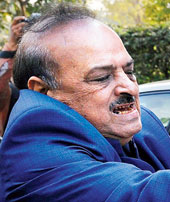
I couldn't believe my eyes. An assault was unfolding right inside the courtroom, which later spread outside.
A group of lawyers went berserk, attacking students, teachers and journalists. The lawyers slapped, punched and abused their victims, raining blows on their heads with shoes. For over an hour, Delhi police constables stood by - most passive, some smiling.
I was in the courtroom of the metropolitan magistrate Lovleen, waiting for the police to produce JNU students' union president Kanhaiya Kumar, arrested on the charge of sedition.
On Monday, I did not hear any anti-India slogan - the reason cited by some lawyers to pounce on a group of teachers.
I entered the court premises at 12.45pm and business was going on as usual. Some students from JNU and other institutions - supporters of Kanhaiya - had gathered there. A few teachers from JNU were sitting in the courtroom much before the scheduled hearing.
I entered the courtroom at 1.50pm. Three court officials and two police constables were present. The courtroom had 11 chairs placed in two rows. The chairs are meant for lawyers and the public. "You can sit here," Professor Ayesha Kidwai told me.
Subhash Chandran K.R., the convener of the All India Lawyers Union, said lawyers as well as visitors could sit on the chairs since in-camera proceedings were not scheduled. I preferred to stand in a corner, possibly the reason why the attackers did not notice me.
At 2.05pm, a group of lawyers entered and asked the teachers to leave, saying the chairs were meant for lawyers alone.
" Bahar jao, yeh chairs lawyers ke liye hai, bahar jao (go out, these chairs are meant for lawyers, go out )," said a lawyer.
Most of the teachers protested. Four other lawyers heckled them. " Pakistan zindabad slogan dete ho aap log (You chant 'Pakistan Zindabad)," one of them said.
A lawyer pulled Rohit, an assistant professor at the Centre of Economic Studies and Planning at JNU, by his hair. He was dragged outside despite protests by other teachers like Kidwai, Janaki Nair and Himanshu. In the argument that ensued, a few other lawyers started chanting " Bharat Mata ki jai".
The police constables in the room did not move till Subhash Chandran requested them to intervene. A few more women constables came from outside. None of the police officers uttered a word against the lawyers but requested the teachers to vacate the room.
The teachers went out. By now, the number of lawyers had grown.
A group of 10 lawyers attacked a student in the court corridor. The youth was subjected to slaps, blows and kicks for three to four minutes before he was taken inside a room by a few policemen.
A few students, who were taking pictures or video, had stopped and were looking for an escape route. But some lawyers had identified them and chased them.
The whole court campus was reverberating with one line: " Saale, Pakistan zindabad bol rahe ho. Maro saale ko (they are saying 'Pakistan zindabad'. Beat them up)."
Kanhaiya was yet to be brought in. Some journalists were taking pictures or reporting over the phone. My phone was switched off.
Manu Shankar, a reporter with the Malayalam channel Kairali TV, was the next target. Slapped and kicked, telltale welts and scratch marks were seen on his face. He said they wanted to check his phone if he had taken any picture. When he said he was a journalist, he was attacked.
They asked a reporter from another Malayalam channel whether she had recorded any image and abused her. At least 20 people and policemen were mute spectators as she ran from the spot for cover. She later requested me not to mention her name in my report.
By then, journalists were being hunted down. I was not using my notepad or phone and was just moving from here to there.
Amit Pandey, a reporter with IBN-7, was asked to show his phone. When he argued with a group of lawyers, they encircled him. He ran. Another journalist was pleading: " Maf kar do, bhai (forgive us, brother)."
I came out through Gate 3, a side gate. As I reached the main gate, where TV channels had parked their OB vans, almost every journalist was asking each other whether they had been beaten up.
Bhavtosh Singh from TimesNow, Alok Singh from The Indian Express, Prachi Yadav from the Navbharat Times and Amiya Kushwaha from the IANS news agency told me they were all either attacked or abused by the lawyers.
It appears that they had protection from the government, one journalist told me.
(A lawyer later told me that most of the advocates who went on the rampage did not practise regularly in the court. They want to be seen in action, hoping that the government would empanel them as its lawyers, he said.)
A few students gathered outside the court. When I approached a Delhi University student, he said: "Please do not ask me anything here."
Delhi police said at night that "FIRs have been registered against unnamed persons".











